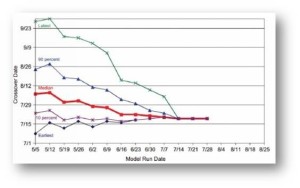by Gavin Roy
West Nile Virus, a known disease threat to humans, was first observed to be carried by mosquitoes in the Midwestern United States in 1999. Since then, state and local governments have enacted mosquito abatement plans that involve large-scale spraying to stem the spread of the disease. While spraying can be lifesaving for humans, birds and animals, it can be fairly expensive. Therefore, in an effort to optimize mosquito spraying schedules, the state of Illinois turned to the Illinois State Water Survey in the 2000’s to develop a method of predicting when the rise of disease-carrying mosquitos might occur each year. A solution to the problem came from a climatologist.
Nancy Westcott and a team of supporting scientists at the Illinois State Water Survey analyzed recent climate datasets side-by-side with incidences of mosquito proliferation in Illinois. From this they developed a model that was able to retroactively pinpoint the “crossover” date of the proliferation of disease-prone mosquitoes to in six out of seven summers from 2002 to 2008 finding a range of July 25 to August 20. Another model’s pinpoint date was within two weeks of the actual date.

An example of Westcott’s mosquito crossover model from the 2005 season using historical climate percentiles and gradually tending toward a single crossover date as the timing of the 81°F+ day threshold becomes more certain. Image reproduced from Westcott, et. al.
One of the main correlations the past data indicated was that mosquito proliferation coincides quite well with the running total of summer days with high temperatures greater than or equal to 81°F. Once a certain number of days with temperatures at this level had been reached, mosquito proliferation usually occurred within a week. The model used guidance from past climate data to hone in on a date when this threshold was historically reached, replacing this data with actual dates from each individual year as 81°F+ days were logged.
By knowing the crossover date with greater and greater accuracy as the season wears on, the state now prepares the resources to spray exactly when the model indicates the crossover will occur. This more accurate method will save time, money and resources.
While there are other factors that Westcott and her team describe to also have some effect on the model-calculated crossover date (including season precipitation and departure from average daily temperature), they assert that these contribute a comparatively small amount of error to the larger high-temperature correlation. The model will continue to improve every year as each successive summer is modeled and retroactively evaluated to see how it performs and to determine what needs to be tweaked.
Sources
Northwest Mosquito Abatement District. Northwest Mosquito Abatement District, 29 Dec. 2011. Web. Accessed 18 Jan. 2012.
Westcott, N. E. et al. “Predicting the Seasonal Shift in Mosquito Populations Preceding the Onset of the West Nile Virus in Central Illinois.” Bulletin of the American Meteorological Society. Sep. 2011: 1173-1180. Print.

Comments are closed.